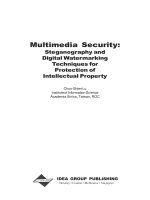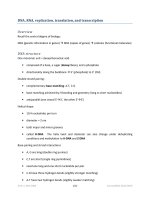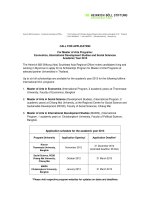Testing three proposed DNA regions (matK, rbcL and ITS2) for identification of camellia euphlebia and camellia chrysantha
Bạn đang xem bản rút gọn của tài liệu. Xem và tải ngay bản đầy đủ của tài liệu tại đây (578.64 KB, 7 trang )
Biotechnology and Seedling
TESTING THREE PROPOSED DNA REGIONS (matK, rbcL and ITS2)
FOR IDENTIFICATION OF CAMELLIA EUPHLEBIA
AND CAMELLIA CHRYSANTHA
Nguyen Van Viet1, Pham Quang Chung1, Do Quang Trung1, Tran Viet Ha1, Sounthone Douangmala2
1
2
Vietnam National University of Forestry
Bolykhamxay College of Agriculture and Forestry, Vientiane, Laos
SUMMARY
Camellia sp. is a yellow flower tea species that have high economic values and have been used as a nutritious
beverage, medicine and an ornamental plant. The identification of these species are based on morphological
characteristics and recently by molecular markers such as matK, ITS2, rbcL. This paper shows that the
nucleotide sequenc of three DNA regions (matK, ITS2, rbcL) can be used to identify Camellia sp. collected
from different areas in Vietnam (Quang Ninh and Bac Giang).The results also show that those three locations
can be amplified by directional PCR. In addition, the nucleotide differences among those DNA regions of the
two Camellia species ranged from 0% to 0.82% suggesting the Camellia chrysantha (Ba Che, Quang Ninh) is a
derivative of Camellia euphlebia (Son Dong, Bac Giang).
Keywords: Camellia chrysantha, Camellia euphlebia, DNA barcode, species identification, Yellow flower tea.
1. INTRODUCTION
The Yellow-flower tea plant belongs to the
Theaceae family, Camellia sp. It has a diverse
species of more than 300 and many different
variants that have been reported all over the
world. For example, 28 and 24 species of the
yellow-flower tea plant were identified in
China and Vietnam, respectively. In Vietnam,
the Camellia sp. distributed in some areas such
as Tam Dao national park (8 species) (Hakoda
et al., 2007), Cuc Phuong national park (2
species), Bac Giang (1 species), Ba Vi national
park (1 species), and some other provinces
such as Quang Ninh. Notably, the yellowflower tea plant living in Ba Che (Quang Ninh)
i originated from C. euphlebia (Ngo Thi Minh
Duyen et al., 2011).
The yellow-flower tea plant is of high
economic value and has been used as
medicinal plants because it contains some
ingredients (Se, Ge, Mn, Mo, V, Zn and some
other elements), which might play roles in
many processes like health protection, anticancer, improvement of elasticity of blood
vessels, regulation of cholesterol-activated
enzymes, lower blood cholesterol, boosting the
immune system (Luong Thinh Nghiep, 2000).
Currently, the number of individuals of the
yellow-flower tea plant is becoming smaller
and their distribution is going to be narrowed
18
down due to eradicated exploitation as well as
increasing stress conditions in habitats caused
by climate change (Ninh T., 2007; Tran Ninh
and Hakoda Naotoshi, 2010). These lead to the
extinction of some medical plants and some
endangered plant species affecting
the
sustainable supply of human pharmaceuticals.
Moreover, studies on the biological, ecological
and culturing characteristics of yellow-flower
tea are still limited, incomplete and not
synchronous. Preservation of these precious tea
species has also been neglected, especially
research on the development and application of
this tea is almost nonexistent (Tran Ninh and
Hakoda Naotoshi, 2010).
In Vietnam, the classification of Camellia
sp. Is mostly
based on morphological
characteristics, which still have some problems
and limitations, especially some species of
Camelliathat which has a similar morphology
leading to difficulties for classification.
Recently, some molecular markers (matK,
ITS2, and rbcL) have been used to classify and
identify some of Camellia sp. such as C.
sinensis, C. petelotii, C. yunnanensis, C.
oleifera, C. taliensis, C. japonica, C.
cuspidata, C. grandibracteata, C. albogigas.
Using the molecular markers together with
morphological characteristics will increase
with precision
and rapidly identify the
JOURNAL OF FORESTRY SCIENCE AND TECHNOLOGY NO. 7 (2019)
Biotechnology and Seedling
difference among organisms. Furthermore,
many research papers have reported the
identification of many specific DNA regions
that can be used as DNA barcoding, which is
individually specific and able to recognize
plants at different levels. Selecting the specific
DNA region as DNA barcoding depends on a
group of specific plants and research proposals
(Kress et al., 2008). Interestingly, the matK
gene expressed
in chloroplast has been
reported as a molecular marker to identify
species and under-species in many plant
species (Yakawa et al., 2006; Storchova et al.,
2007; Ford et al., 2009).
In this paper, we report a nucleotide
comparison of three DNA regions (matK, ITS2,
rbcL) for two species of Camellia, C.
euphlebia và C. chrysantha. These results can
be used as a method to classify and identify
Genes
matK
rbcL
ITS2
species of Camellia that enhances the
conservation efficiency and the development
of valuable gene sources in Vietnam.
2. RESEARCH METHODOLOGY
2.1. Materials
DNA samples: 6 fresh leaves from each
species were collected from natural forests Son
Dong - Bac Giang and Ba Che - Quang Ninh.
Chemicals for total DNA extraction: CTAB,
SDS, EDTA, Tris-HCl, NaCl, PVP, Ascorbic
acid, Mercaptoethanol, Potassium acetate,
Sodium acetate, and Ethanol from Wako
(Japan) and Merck (Germany); PCR and
electrophoresis from Fermentas (Germany),
Bioneer
(Korea),
Research
Organics
(America).
Primer sets for PCR amplification of matK,
rbcL và ITS2 (Table 1).
Table 1. Nucleotide sequence of primers
Sequence (5’-3’)
Fragment size
Forward: ACCCAGTCCATCTGGAAATCTTGGTTC
920 bp
Reverse: CGTACAGTACTTTTGTGTTTACGAG
Forward: GTAAAATCAAGTCCACCACG
600 bp
Reverse: GTAAAATCAAGTCCACCGCG
Forward: ATGCGATACTTGGTGTGAAT
550 bp
Reverse: TCCTCCGCTTATTGATATGC
2.2. Methods
Plant samples: Samples were collected and
labelled in order as following CeBG1,
CeBG2, CeBG3, CeQN1, CeQN2 và CeQN3.
Fresh-leaves samples immediately put into a
freezed container and stored at -800C until
DNA extraction.
Total DNA extraction: Total DNA was
extracted by CTAB method (Saghai Maroof et
al., 1984). Briefly, about 100 mg sample was
ground in 600 mL CTAB solution (2% CTAB,
20 mM EDTA, 1.4 M NaCl, 1% betamercaptoethanol, 100 mM Tris-HCl pH 8.0).
Then, the total solution was transferred into 1.5
mL centrifuge tubes and incubated at 650C in
30 minutes. Next step, the same volume of
chloroform was added and mixed by inverting
tubes 10 times. All samples were centrifuged at
10000 rpm in 10 minutes. The supernatant was
Reference
Cuenoud et
al., 2002
Kress et al.,
2007
Chen et al.,
2010
transferred into new 1.5 mL tubes and
precipitated DNA by adding 500 l cold
isopropanol. The mixture was incubated at -200C
for 2 hours before centrifuging at 10000 rpm in
10 minites. The pellet was then washed twice
with 70% ethanol solution and dried at room
temperature for 30 minutes. The pellet was
dissolved in 50 l TE buffer.
PCR amplification and DNA sequencing:
The sequences of three genes (matK, rbcL và
ITS2) were amplified by PCR using PCR
machine (model: 9700 Thermal Cycler Applied
Biosystems, American). The PCR master mix
for one reaction (25 l) consists of 2.5 l 10X
Taq buffer, 2.0 l dNTPs (2.0 mM), 1.0 l for
each of forward and reverse primer (10 nM), 0.5
l Taq DNA polymerase (5U/l), 1.0 l DNA
templates (50 ng/μl), and water was added to
get the final volume of 25 l. The PCR
JOURNAL OF FORESTRY SCIENCE AND TECHNOLOGY NO. 7 (2019)
19
Biotechnology and Seedling
program as followed: 950C: 3 minutes, 40
cycles of {950C: 30s, 570C - 620C: 30s, 720C: 1
minute}, 720C: 7 minutes. PCR samples were
kept at 40C and separated by electrophoresis on
1.2% agarose gel. The PCR product was then
gel purified using a Norgen biotek kit (Canada)
and sequenced by using ABI PRISM®3730xl
DNA Analyzer (ABI, Foster City, CA, USA).
Analysis of DNA sequence (DNA barcode):
The sequences were processed using BioEdit
software (version 7.2.5) and blasted on NCBI
website Using BLAST NUCLEOTIDE tool
( />3. RESULTS AND DICUSSION
3.1. DNA extraction and PCR amplification
of three genes (matK, rbcL and ITS2)
Total DNA was extracted by CTAB
methods as described by Saghai Maroof et al.
(1984). The result was shown in figure 1. As
can be seen, the specific bands were clean and
have no contamination of protein and RNA.
This suggests the total DNA can be used as
template for PCR amplification.
The PCR results presented all three genes
which were successfully amplified from six
samples (Figure 2 and Table 2). These
indicated that the good quality of extracted
DNA and PCR products are clean enough for
sequencing. Moreover, the results also showed
the PCR procedure was optimized for
amplification of the target DNA fragments.
Figure 1. Genomic DNA extraction from six leaf samples
Figure 2. PCR amplification of rbcL gene
(DNA template from six leaf samples (CeBG1, CeBG2, CeBG3, CeQN1, CeQN2, CeQN3) were used.
The bands as expected with 589 bp. M: DNA marker 1kb)
No.
1
2
3
4
5
6
20
Table 2. Analysis of DNA sequence of three proposed genes
DNA region
Aspects
matK
rbcL
PCR amplification (%)
100
100
Correct Sequence (%)
100
100
Expected size (bp)
921
589
Different position
0
2
Number of different nucleotide
0
2
Distention (% different nucleotide)
0
0.34
ITS2
100
100
367
3
3
0.82
JOURNAL OF FORESTRY SCIENCE AND TECHNOLOGY NO. 7 (2019)
Biotechnology and Seedling
3.2. Analysis of sequence of three DNA
regions
3.2.1. Sequence analysis of matK gene
The sequence result of matK gene from all
Camellia samples showed that the PCR
products were clean and not be affected by
background. These sequences were then
edited and aligned by using Bioedit software
(ver. 7.2.5). The results indicated that the
sequence matched with DNA regions that have
921 bp, 589 bp and 367 bp for matK, rbcL và
ITS2, respectively (Table 2).
In the next step, we compared the DNA
region of three genes between two Camellia
samples, one from Son Dong - Bac Giang and
the other from Ba Che - Quang Ninh, to find
the number and position of different
nucleotides. These results can be useful for
classification of species, in particular,
confirming that Camellia species from Quang
Ninh and Bac Giang are different species or
belonging to the same species. Basically, it is
known that the difference of nucleotide
sequence of DNA barcoding regions among
species is higher than that in one species, then
this difference can be used as DNA barcoding
for that species (Fabrizio et al., 2011).
Figure 3. The alignment of matK genes from Camellia samples of Quang Ninh and Bac Giang
As we expected, the alignment analysis of
matK DNA region from our studies with the
matK sequence of Camellia sp. from
GeneBank showed the difference is from 1 2%. This is consistent with previous studies.
Interestingly, the alignment results of samples
from Quang Ninh and Bac Giang presented 0%
for the differences (Figure 3), which is normal
for individuals in one species.
3.2.2. Sequence analysis of rbcL gene
We applied the same method to analyze
sequence of rbcL gene. The results showed the
JOURNAL OF FORESTRY SCIENCE AND TECHNOLOGY NO. 7 (2019)
21
Biotechnology and Seedling
difference is from 1 - 3% for our rbcL
sequence compared with rbcL sequence from
the Genebank. This is consistent with previous
studies. However, the nucleotide difference
between two Camellia samples from Quang
Ninh and Bac Giang is 0.34% suggesting two
samples are from one Camellia species.
Figure 4. The alignment of rbcL genes from Camellia samples of Quang Ninh and Bac Giang
3.2.3. Sequence analysis of ITS2 gene
In next step, the same method was applied
to analyze ITS2 sequences. The alignment of
our ITS2 sequencewith the one from Genebank
showed the difference is from 1 - 3%, while
the nucleotide difference between two
Camellia samples from Quang Ninh and Bac
Giang is 0.82% suggesting two samples are
from one Camellia species.
Figure 5. The alignment of ITS2 genes from Camellia samples of Quang Ninh and Bac Giang
22
JOURNAL OF FORESTRY SCIENCE AND TECHNOLOGY NO. 7 (2019)
Biotechnology and Seedling
All in all, our results suggest that among
5. Ford C.S, Ayres K.L, Toomey N, Haider N, Stahl
proposed DNA regions, matK and ITS2 are
J.V.A, Laura J, Kelly, Wikstrom N, Peter M,
Hollingsworth R, Dupp R.J, Sarah B, Hoot R.S, Cowan,
specific for an evolution in which the
nucleotide difference is enough for species
identification, meanwhile, rbcL is specific for
the highly conserved evolution that is normally
used for identification of individuals within a
species (CBOL, 2009). All three DNA regions
Mark W, Chase, Mike J, Wilkinson. (2009). Selection of
candidate coding DNA barcoding regions for use on
DNA plants. Botanical Journal of the Linnean Society,
159 (1): 1-11
6. Hakoda N, Kirino S.H, Ninh T (2007). New
species of genus camellia in Vietnam. International
Camellia Journal, 39:54-57.
presented the nucleotide sequence for samples
7. Kress J.W, Erickson D.L (2008). DNA barcodes:
from Quang Ninh and Bac Giang that belong
Genes, genomics, and bioinformatics. Proc NatlAcad
Sci U S A, 105(8):2761-2762.
to a range for individuals of one species. That
result is consistent with the study of Ngo Thi
Minh Duyen et al. (2011).
Coding rbcL Gene Complements the Non-Coding trnHpsbA Spacer Region. PLoS ONE 2(6): e508.
4. CONCLUSION
All three proposed genes (matK, rbcL và
ITS2)
were
successfully
amplified
and
sequenced. The nucleotide difference between
Camellia species from Quang Ninh and Bac
Giang ranged from 0 - 0.82% The result initially
confirmed that Camellia samples from Quang
Ninh and Bac Giang are the same species.
REFERENCES
1. CBOL Plant Working Group (2009). A DNA
barcode for land plants. Proc Natl Acad Sci USA, 106:
12794-12797.
2. Chen S (1), Yao H, Han J, Liu C, Song J, Shi L,
Zhu Y, Ma X, Gao T, Pang X, Luo K, Li Y, Li X, Jia X,
Lin Y, Leon C (2010). Validation of the ITS2 region as
a novel DNA barcode for identifying medicinal plant
species. PLoS ONE 5(1): e8613.
3. Cuenoud P, Savolainen V, Chatrou L.W, Powell
M,
Grayer
R.J,
Chase
MW
8. Kress WJ, Erickson DL (2007). A Two-Locus
Global DNA Barcode for Land Plants: The
(2002).
Molecular
phylogenetics of Caryophyllales based on nuclear 18S
rDNA and plastid rbcL, atpB, and matK DNA
sequences. American Journal of Botany, 89: 132-144.
4. Fabrizio De Mattia, Ilaria Bruni, Andrea
9. Luong Thinh Nghiep (2000). Chinese name of
Camella sp. Kim Thuan publisher, Bac Kinh - Trung Quoc.
10. Ngo Thi Minh Duyen, Ngo Quang Hung, Le Sy
Doanh, Ngo Quy Cong, Nguyen Van Khuong (2011).
Evaluation of growth and generation ability of Camella
sp. from Northern provines. Forestry Science and
technology journal, 4: 1954 - 1965.
11. Ninh T. (2007). Diversity of wild Camellia
species of Tam Dao Nationnal Park. Journal of Science Natural Science and Technology, 23:152-154.
12. Saghai - Maroof M.A, Soliman K.M, Jorgensen
R.A, Allard R.W (1984). Ribosomal DNA spacer-length
polymorphism
in
barley:
Mendelian
inheritance,
chromosomal location, and population dynamics. Proc
Natl Acad Sci, 81: 8014-8019.
13. Storchova H, Olson M.S (2007). The architecture
of the chloroplast psbA-trnH non coding region in angio
sperms. Plant systematic and evolution. Biomedical and
life sciences, 268: 235 – 256.
14. Tran Ninh, Hakoda Naotoshi (2010). Camellia
species in Tam Dao national park. Project for
management of Tam Dao national park and buffer zone,
pp. 30.
15. Yakawa M, Tsudzuki T, Sugiura M (2006). The
Galimberti, Francesca Cattaneo, Maurizio Casiraghi,
chloroplast genome of Nicotianas sylvestris and
Nicotiantomentosisformis:
complete
sequencing
Massimo Labra (2011). A comparative study of different
confirms that the Nicotiana sylvestris progenitor is the
DNA barcoding markers for the identification of some
maternal genome donor of Nicotiana tabacum. Mol
genet genomics, 275: 367 - 373.
members of Lamiacaea. Food Research International,
44: 693-702.
16. />
JOURNAL OF FORESTRY SCIENCE AND TECHNOLOGY NO. 7 (2019)
23
Biotechnology and Seedling
THỬ NGHIỆM BA VÙNG DNA TIỀM NĂNG (matK, rbcL và ITS2) CHO
NHẬN DẠNG LOÀI TRÀ HOA VÀNG TẠI BẮC GIANG (Camellia euphlebia)
VÀ QUẢNG NINH (Camellia chrysantha)
Nguyễn Văn Việt1, Phạm Quang Chung1, Đỗ Quang Trung1, Trần Việt Hà1, Sounthone Douangmala2
1
2
Trường Đại học Lâm nghiệp
Trường Cao đẳng Nông - Lâm Bolykhămxay, Viêng Chăn, Lào
TÓM TẮT
Trà hoa vàng (Camellia sp.) là loài cây đa tác dụng có giá trị kinh tế cao, dùng làm đồ uống bổ dưỡng, dược
liệu và trang trí cảnh quan. Bài báo này công bố kết quả so sánh trình tự nucleotide của ba vùng DNA (matK,
ITS2, rbcL) giữa loài Trà hoa vàng ở Ba Chẽ, Quảng Ninh (Camellia chrysantha) và loài Trà hoa vàng ở Sơn
Động, Bắc Giang (Camellia euphlebia). Tỷ lệ thành công cho khuyếch đại PCR cho ba đoạn mã vạch là
100%. Tỷ lệ đọc thành công trình tự hai chiều đạt được từ sản phẩm PCR là 100% cho ba đoạn mã vạch DNA.
Độ dài trình tự nucleotide phân tích thuộc vùng DNA lần lượt là 921bp, 589 bp và 367 bp cho matK, rbcL và
ITS2. Kết quả phân tích ba vùng DNA lựa chọn đều cho thấy sự sai khác nucleotide giữa hai loài Trà hoa vàng
trong nghiên cứu dao động trong khoảng từ 0% đến 0,82% thuộc sự khác biệt giữa các thể trong loài, có nghĩa
là Trà hoa vàng ở Ba Chẽ, Quảng Ninh (Camellia chrysantha) là một dẫn xuất của loài Trà hoa vàng ở Sơn
Động, Bắc Giang (Camellia euphlebia).
Từ khóa: Camellia chrysantha, Camellia euphlebia, DNA mã vạch, giám định loài, Trà hoa vàng.
Received
Revised
Accepted
24
: 01/11/2018
: 08/5/2019
: 15/5/2019
JOURNAL OF FORESTRY SCIENCE AND TECHNOLOGY NO. 7 (2019)









